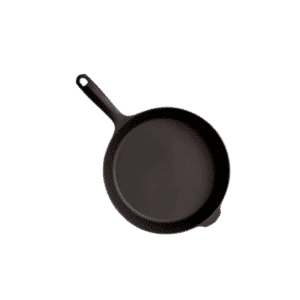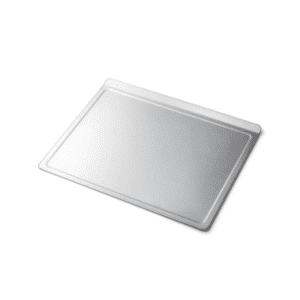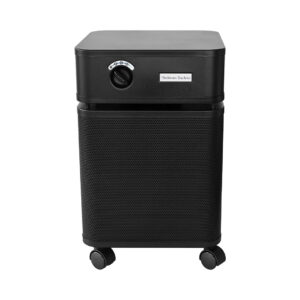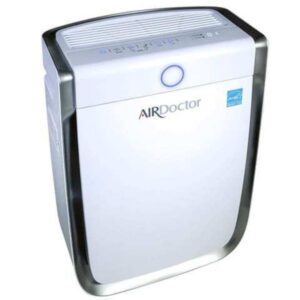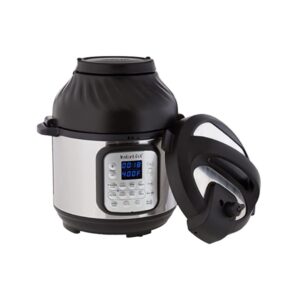Air fryers have become a trendy “healthier” alternative to traditional deep-frying. Whether you’re looking to make a quick and easy weeknight dinner or impress guests with a homemade meal, an air fryer can help you do just that. However, with thousands of air fryers on the market, how do you find the safest ones? Are air fryers toxic? Do non-toxic air fryers even exist? How do you spot misleading appliance marketing?
Don’t worry, I break it all down for you! Keep reading to learn more about the best air fryers free of toxic chemical coatings.
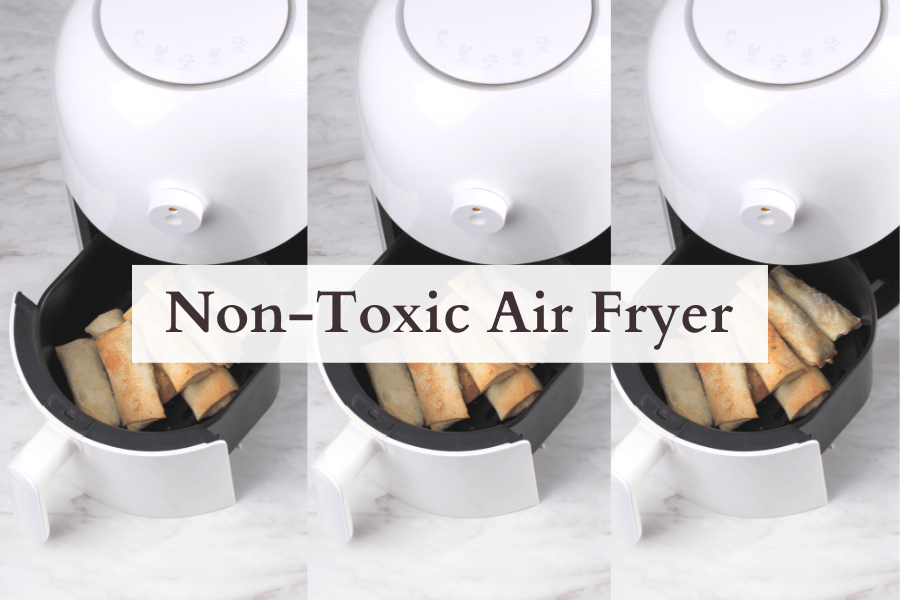
Note: This article contains affiliate links, meaning In On Around will make a small commission at no additional cost to you. This helps me maintain the site. As always, I value full transparency & only work with brands I love and trust.
What Is An Air Fryer?
So, let’s start simple. You’ve probably heard people raving about air fryers, but what are they? An air fryer is a small kitchen appliance that’s similar to a convection oven. It cooks and crisps food by circulating hot air. The hot air is generated by an electric heating element with a small fan. Usually, food is placed on a perforated basket or tray, making the food crispy on the outside and tender on the inside without the need for excess oil.
Air fryers can be used to cook a wide variety of foods such as organic chicken, fish, vegetables, and even baked goods! They’re marketed to be a healthier alternative to traditional deep-frying methods since they use much less oil, and can cook food more evenly and quickly.
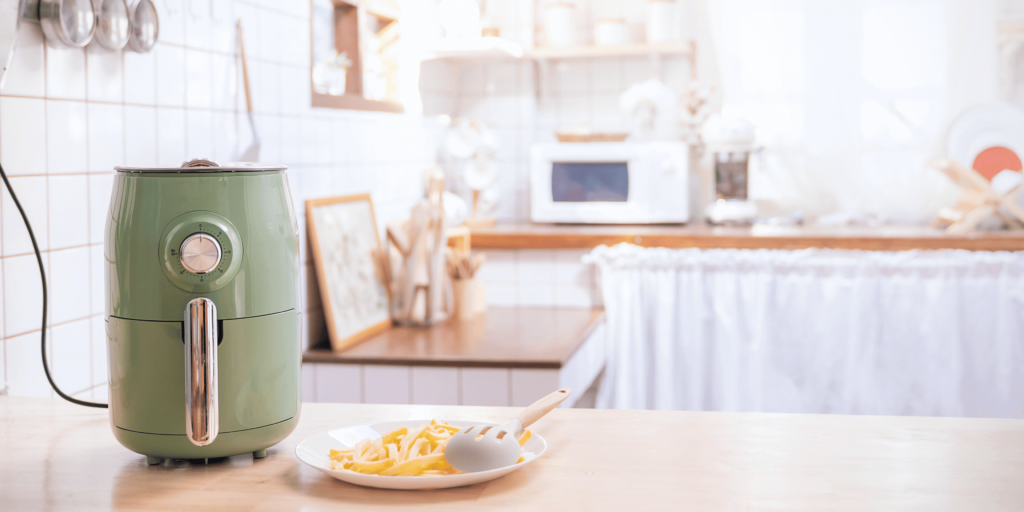
7 Pros & Cons Of Air Fryers
Let’s dive into all of the potential pros and cons of air frying (… some may surprise you!):
The Benefits Of Air Fryers
Air frying can have several benefits, including:
1 – Uses Less Oil
Air fryers use less oil than traditional deep-frying methods (some up to 85% less oil), which makes the food cooked in them lower in fat and calories. You’ll get a similar deep-fried taste without the extra oil.
To learn more about healthy cooking oils, check out: Seed Oils & Inflammatory Oils To Avoid While Cooking.
2 – Faster Cooking
Air fryers cook food quickly and evenly (sometimes even 50% faster), which is especially useful for busy individuals who want to have a meal ready in a short amount of time.
3 – Versatility
Air fryers can be used to cook a wide variety of foods, such as french fries, chicken, fish, vegetables, and even baked goods. They’re multi-purpose!
4 – Convenience
Air fryers are usually small and compact, so they don’t take up much counter space, making them easy to store when not in use. It can be a better, more convenient option compared to microwaving.
Many people love air fryers because they’re quick & convenient.
5 – Reduced Smoke & Odor
Air fryers produce less smoke and odor compared to traditional deep-fryers, making them a better option for indoor cooking! [Make sure you read the downsides section for more information on this.]
6 – Consistency
Air fryers cook food more consistently due to the circulating hot air which ensures that food is cooked evenly all around.
7 – Safety
Air fryers have a built-in timer, temperature control, and automatic shut-off feature (in some models) that makes them safer than traditional deep fryers. This also helps to save on energy costs!
For these reasons, they’re a popular choice among health-conscious individuals and busy families!
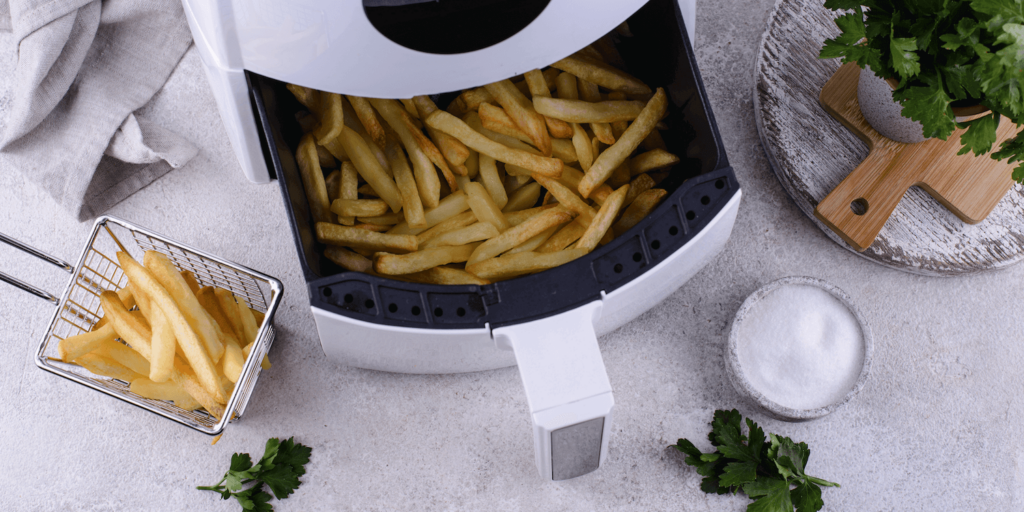
The Downsides of Air Fryers
Air fryers are a popular kitchen appliance, but they do have a few downsides to consider:
1 – Toxic Coating
Most air fryers use non-stick coatings which are toxic to the body and environment. PTFE, PFOA, and BPA chemicals can be on the interior of the air fryer (we’ll dive into this further in the article).
These toxic coatings can also release PTFE and PFOA into the air when heated to high temperatures or when the non-stick coating is damaged (which can be very harmful to inhale). If the coating is aerosolized in the air, it can sprinkle down on food while cooking.
Most non-stick kitchen appliances use a toxic coating.
2 – Plastic Use
Most air fryers are primarily made out of plastic, which is bad for your health and the environment. Usually, you can smell (and inhale) the plastic the first few times you heat up the appliance (… gross).
3 – Deceptive Marketing
“Non-toxic” options are not always safe: If you’re trying to avoid plastic, you may think about getting a glass or stainless steel air fryer. While these might look like better options, they’re not always what they seem. We’ll dive into this further in the article.
4 – Not Always Healthier
Just because something is air-fried, doesn’t mean it’s a healthy food choice. Air-fried cinnamon buns are still unhealthy cinnamon buns! Don’t be fooled. Air frying is certainly better than deep frying, but that doesn’t necessarily mean that everything you put in the air fryer will be healthy. If the food is coated in processed seed oils or sugar, air frying will make no difference – it’s still unhealthy.
Air-fried does NOT mean the food is healthier.
5 – Capacity
Air fryers have limited capacity and are not suitable for cooking larger amounts of food.
6 – Crowding
Crowding the air fryer basket with too much food can prevent the hot air from circulating properly, resulting in unevenly cooked food. Be extra careful if you’re cooking raw meat – always make sure to use a meat thermometer to ensure it reaches the temperature to kill bacteria.
7 – Potential For Acrylamide
Last, but certainly not least: cooking at a high temperature can increase acrylamide. Acrylamide is a chemical compound that is formed when certain foods are cooked at high temperatures, such as frying, roasting, and baking.
Exposure to toxic compounds such as acrylamides from starchy foods (like potatoes and cereal grains), as well as polycyclic aromatic hydrocarbons and heterocyclic amines (from meats like beef, pork, poultry, and fish), can occur when cooking these foods at high temperatures.
Acrylamide = Probable carcinogen
Acrylamide forms as a result of a chemical reaction called the Maillard reaction, which occurs when sugars and amino acids present in the food are heated together. It’s not a chemical that’s added to food, but it is created during the cooking process.
Acrylamide has been classified as a “probable human carcinogen” by the International Agency for Research on Cancer (IARC) and is known to cause cancer in laboratory animals (… big yikes). Long-term exposure to acrylamide has been linked to an increased risk of several types of cancer, including ovarian cancer, kidney cancer, and endometrial cancer.
What Is Teflon?
Teflon is the most popular brand name for polytetrafluoroethylene (PTFE), which is a form of PFOA (also known as C8). PFOAs are classified as “forever chemicals” (per- and polyfluoroalkyl substances), which can cause a host of health issues. It’s a favorite chemical amongst cookware manufacturers!
Teflon was first developed by DuPont in 1938, and it’s a type of plastic that is known for its non-stick properties. It’s used as a coating on cookware, such as frying pans, baking sheets, and waffle irons. When Teflon cookware is heated to high temperatures, it can release toxic fumes into the air. When Teflon is scratched or damaged, it can flake into the food.
It’s best to avoid all non-stick cookware, when possible.
To learn more about non-toxic cookware, check out: Ceramic vs Stainless Steel Cookware – Non-Toxic Guide
Air Fryer Vs. Broiler
Air fryers and broilers are both kitchen appliances that are used to cook food, but they work in different ways – don’t be confused! While an air fryer is a countertop appliance that uses hot air, a broiler is a kitchen appliance that uses radiant heat. With broilers, the heat is generated by an electric or gas heating element above the food. Broilers are typically found in ovens and are used to cook food quickly and achieve a crispy, browned top surface.
Both appliances can be used to cook a wide variety of foods, but air fryers are typically used to cook smaller and lighter foods, while broilers are used to cook heavier and larger meals.
Importance Of Buying A Non-Toxic Air Fryer
The accumulation of chemicals can cause long-term health issues. While some of these chemicals have been phased out, they’re still ever present in many cookware and air fryer products.
Non-stick coatings, PFOA and PTFE have a long list of potential health effects, such as:
- Cancer (breast, thyroid, testicular, ovarian, bladder, prostate, and more) [1]
- Heart disease & cardiovascular issues [2]
- Kidney disease [3]
- Liver disease [4]
- Reduced immunity [5]
- Fertility issues, like higher miscarriage and lower sperm count [6, 7]
- Endocrine disruption (hormone disruption) [8]
- Thyroid dysfunction [9]
… and much, much more. Clearly, the chemicals used in air fryers are not healthy!
Aside from the impact on human health, forever chemicals are extremely hazardous to our environment. They’re said to be “forever” chemicals because they don’t decompose. It’s toxic pollution!
To learn more about forever chemicals, check out: Per/Polyfluoroalkyl Substances (PFAS) – What Are Forever Chemicals & How Do We Avoid Them? To learn more about PFAS in clothing, check out: Non-Toxic Activewear: BPA & PFAS In Workout Clothes?
Higher temperatures + longer cooking = More acrylamide
What To Avoid
It is very difficult to find an air fryer without a non-toxic coating. The California Proposition 65 warning label is usually included on the product. Sometimes this is because of the chemicals or heavy metals found in the electrical cord, while other times it’s because of the chemicals used inside the unit or on the trays. It’s difficult to know exactly just from looking at the warning label.
1 – Non-Stick Coatings
The air fryer material is the most important thing to consider when shopping for one. Avoid anything with a non-stick coating, even if it’s PTFE and PFOA-free. Oftentimes, manufacturers use a “proprietary” chemical blend for easier cleaning, but these chemicals can do more harm than good. Some brands even use a chemical coating on the product during shipment to prevent scratches.
Beware: there are a TON of brands that market themselves as BPA, PFOA-free, and dishwasher-safe. This does NOT mean that they are non-toxic. There is a ton of misleading marketing surrounding cookware and air fryers. PFOA is a type of PFAS. Just because something says PFOA-free does not mean it’s free of all PFAS.
A lot of drip trays are non-stick, which I’d avoid using when possible (or at least avoid putting food directly on it).
PFOA-free doesn’t mean PFAS-free.
2 – “Fake” Stainless Steel
Be careful when buying air fryers that claim to be stainless steel. Brands commonly say this if the exterior is stainless steel, not always the interior. “Stainless steel finish” or “brushed stainless steel” usually refers to the exterior only. Oftentimes, the cookie sheets or mesh trays used with the food are not stainless steel whatsoever. Most air fryers have non-stick interior walls for easy cleaning.
For instance, this Cuisinart Air Fryer looks like a good option, BUT they don’t confirm the material use for the trays. If it actually uses high-quality stainless steel (and not ceramic-coated, aluminum, etc…) it would be a great choice, but without that information, it’s impossible to know.
While very difficult to find in the air fryer space, pure stainless steel is best. Most air fryer brands don’t even disclose the materials used in their cooking pans or trays. If that’s the case, it’s always best to assume they’re made from cheaper materials, such as:
- Aluminum
- Galvanized steel (this contains zinc coating)
- Ceramic-coated stainless steel (can contain nano-particles)
- Non-stick coated or coated stainless steel
- Chrome-plated
3 – Wifi Or “Smart” Fryers
We’re in the age of “smart” technology. It’s best to skip any air fryers that link to wifi (… yes, they’re a thing)! It’s completely unnecessary and can increase your exposure to electromagnetic frequencies (EMFs).
Other Best Practices
If you don’t have a lower-tox air fryer, opt for steaming or baking instead on non-toxic cookware, like 360 Cookware. Cooking food at a lower temperature (where appropriate) can help reduce acrylamide formation. Make sure to avoid eating any charred and heavily crisped food. Aim for a golden yellow color when air frying food (based on cooking instructions).
When cooking, it’s always best to have a high-quality air purifier running with windows open (if possible). Check out the best air purifiers here: Best Air Filter Buying Guide
Beware of stainless steel marketing! Usually, this is only referring to the exterior of the air fryer… not the interior trays used.
Best Non-Toxic Air Fryer Brands
Don’t be fooled – most of the “non-toxic” air fryers listed in other articles and blog posts are NOT actually non-toxic. Unfortunately, there’s no “perfect” non-toxic air fryer on the market. I looked through a wide range of brands, but most don’t meet my standards. Does this mean you should avoid using an air fryer altogether? Not necessarily – that’s your choice, but it’s important to keep in mind if you’re trying to lower the chemical burden on your body.
“Better” Options
Here are the “better” options:
- Instant Pot Duo Crisp 11-in-1 Air Fryer and Electric Pressure Cooker Combo
- According to their customer service, all of the internal pieces are stainless steel, including the air fryer basket. It comes with one basket that looks ceramic (it’s a darker grey), so I’m a bit suspicious of that one.
- Galanz Air Fryer Toaster
- The racks are stainless steel and the pan and crumb tray are galvanized steel (which I’d avoid using)
- Some Yedi products – I called their customer service team to discuss the quality of the product. They use a mixture of stainless steel and non-stick coating, depending on the model and accessory used. If you purchase with them, it’s best to call their customer service team to confirm the materials for the specific accessories you’re using.
- Yedi Total Package 18-in-1 Air Fryer
- The drip pan has a non-stick coating, but the chamber and most accessories are stainless steel.
- Yedi Tango – Air fryer and pressure cooker combination
- It comes with skewers and a small bowl with 2 handles, which are both apparently stainless steel. The larger bowl is a combination of non-stick and stainless steel, which I’d avoid using.
- Yedi Total Package 18-in-1 Air Fryer
- Fritaire
- Their customer service team confirmed that the rotisserie skewer, rack, and basket are stainless steel. The rotisserie basket is aluminum. They use a glass bowl (undetermined if it’s borosilicate glass), but definitely a better option than most.
Emeril Lagasse Power Airfryer 360 is another popular “non-toxic” air fryer, however, when I spoke with their customer service department, they confirmed that only the exterior is stainless steel. The interior has a non-stick coating. I’m not a fan of this option.
Halogen Ovens (not quite an “air fryer,” but can achieve a similar result):
- Nutrichef – uses a glass bowl and convection oven top
- Classic Cuisine – uses a glass bowl and halogen lamp
- Big Boss Air Fryer (although it’s been out of stock for quite some time)
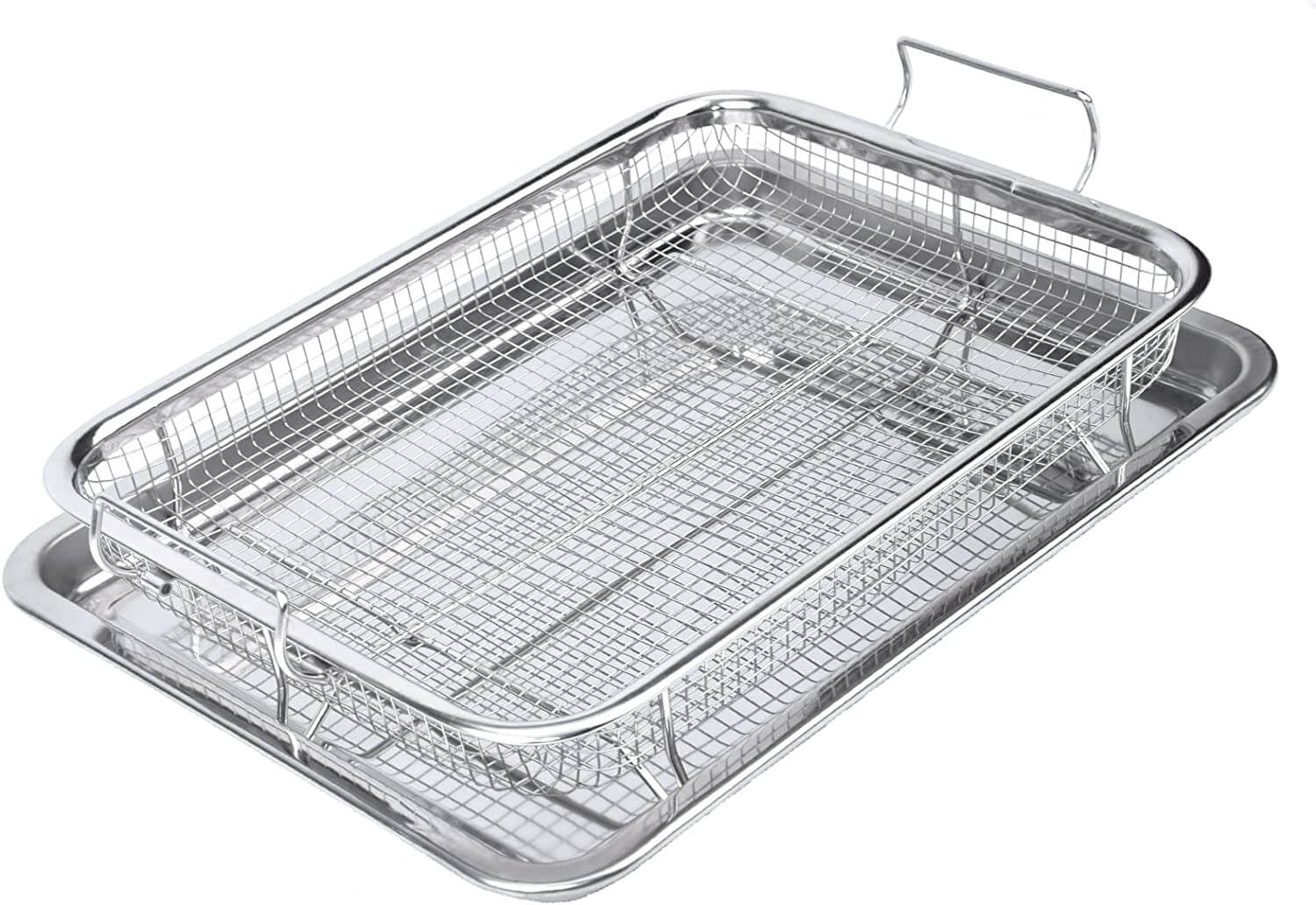
Another Option – Buying New Trays
Since it’s so difficult to find 100% non-toxic air fryers, you can also purchase new trays for your current model. If you already have an air fryer, you can purchase “better” frying baskets made out of stainless steel (if they fit your unit). Check the dimensions of your current air fryer before purchasing:
This can also be a good option if you don’t want to throw away/donate an air fryer you just purchased. These may not always be the highest-quality stainless steel, but they can be a better option than non-stick coated pans.
Note: I haven’t tried these models personally, so I can’t speak about their performance, although they have great reviews. Chefman, Breville, Cuisinart, Pampered Chef, Kitchenaid, Philips, Ninja, and Cosori all sell popular air fryers, but I haven’t found ones made of materials that I personally like.
Final Thoughts – Non-Toxic Air Fryers
Air fryers are a trendy fun purchase that’s here to stay in the kitchen appliance world. Despite their convenience, most of them use toxic non-stick coatings which can impact your health. It’s very difficult to find an air fryer without a non-toxic coating or one that’s 100% non-toxic. However, there are “better” options you can purchase, if within your budget.
Remember: with most cookware, you will never be able to fully avoid all toxins. It’s more important to limit your exposure and your body’s burden versus aiming for perfection. Now you’re a more informed, conscious consumer!
⬇ Pin this “The Safest Air Fryers Without PFAS?” pic on Pinterest for future reference! ⬇
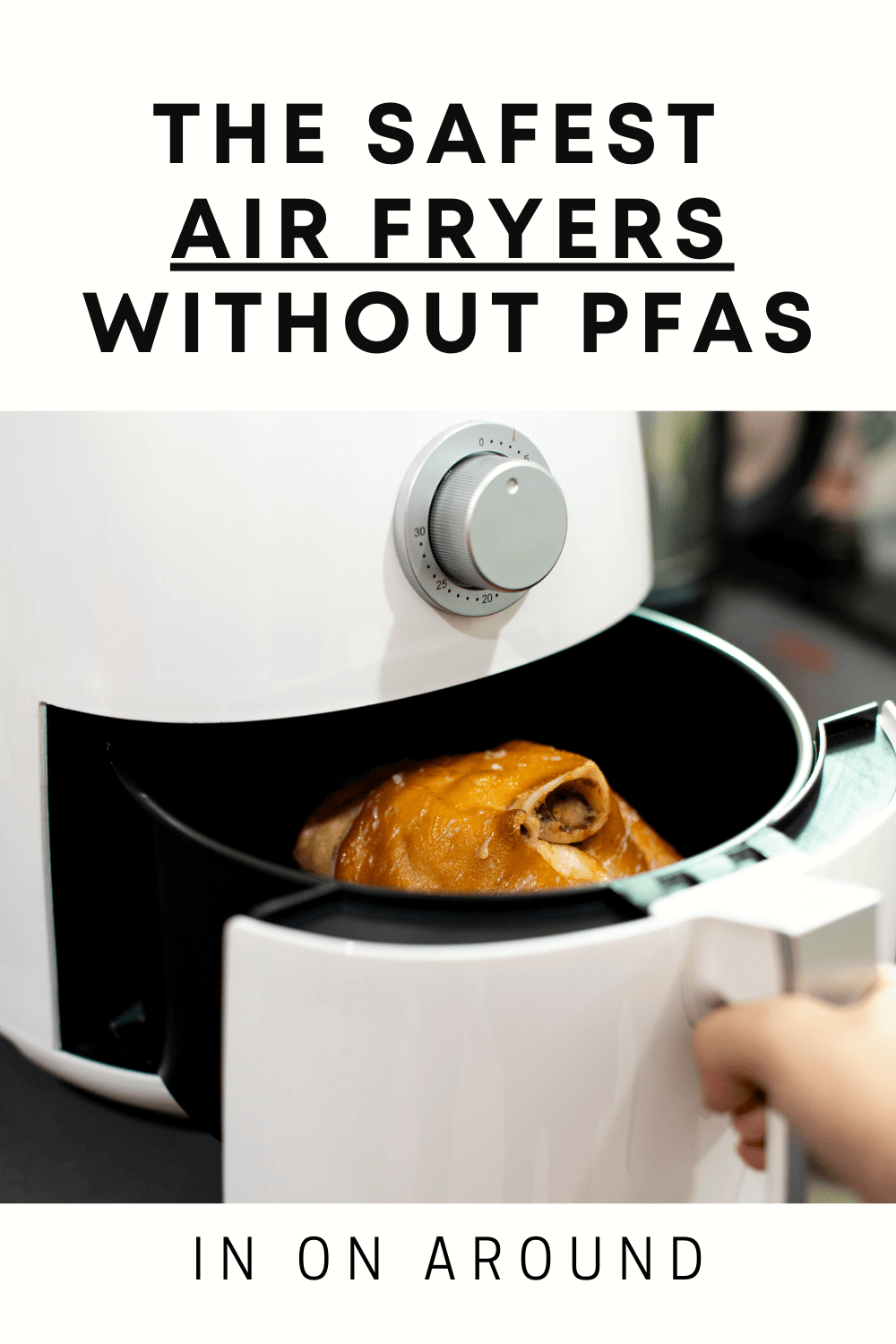
Frequently Asked Questions – Safe Non-Toxic Air Fryer
Click on the below FAQs to learn more about safe, chemical-free air fryers.
What are the benefits of using an air fryer?
Are air fryers toxic?
Can I cook frozen foods in an air fryer?
Is it safe to use non-stick spray or oil in an air fryer?
Do you own an air fryer?
Let me know your thoughts and key takeaways in the comments below!
You can watch our web story here.
xoxo,

Want to read more? Check out my other articles here!
Other references on Non-Toxic Air Fryers: OKitchen Daily, Expert of Home, Best Reviews, The Good Life Designs, Centre for Food Safety, Mamavation, Non-Tox U, Jenuine Home, Kitchen Hanker, New House Checklist, Plateful Health, Detoxinista, Kitchen Deets,
Copyright In On Around LLC 2023 ©. The statements made on this website have not been evaluated by the FDA (U.S. Food & Drug Administration). They are not intended to diagnose, treat, cure, or prevent any disease. The information provided by this website should not be used as individual medical advice and you should always consult your doctor for individual recommendations and treatment. The information contained in this site is provided on an “as is” basis. Related to this site, there are no guarantees of completeness, accuracy, usefulness, or timeliness. In On Around LLC assumes no responsibility or liability for any errors or omissions in the content of this site.

